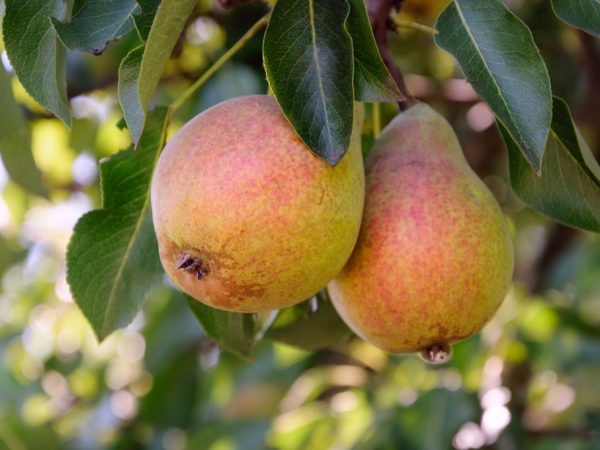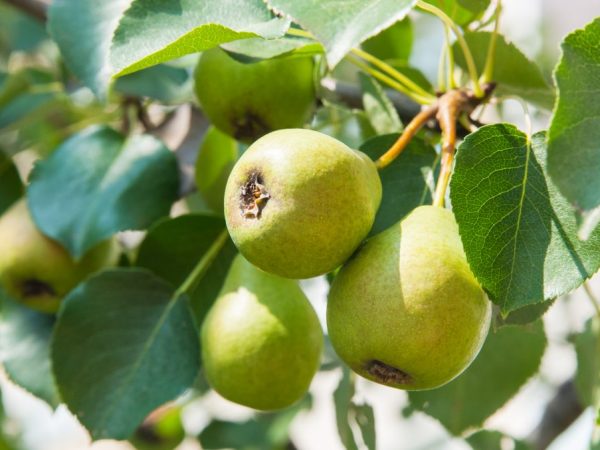The best pear varieties for Siberia
All varieties of pears for Siberia are resistant to temperature extremes and normally tolerate severe frosts in winter. All plants adapted to the conditions of the western part of Siberia are conventionally divided into plants of early, middle and late ripening.

The best pear varieties for Siberia
Early
The best early varieties for growing in Siberia:
- Severyanka. The frost resistance of this variety is fully consistent with its name. Fruits reach 170 g and ripen in early August. The pulp is white and juicy. It has a characteristic aroma and flavor. The plant begins to bear fruit in the 3rd year. The tree is distinguished by its average height and winter hardiness. The plant practically does not affect the gall mite and scab.
- Rainbow. Fruiting of a plant of this variety occurs 3 years after planting. It needs pollination. The best neighbor is Severyanka. The tree of this variety is not afraid of bacterial burns, as well as scab and gall midge. The pulp of the fruit is juicy. The peel shows a gradient from light green to deep red.
- Penguin. The tree is characterized by winter hardiness and early fruiting. Fruits reach a mass of 120 g. Fruit color is orange. The pulp is juicy. There is no pear astringency in the taste. The fruits ripen in early August.
- Duchess. The fruits have a delicate flavor and aroma. The mass of one fruit reaches 180 g. Ripening begins at the end of July. The fruits retain their presentation for a month from the date of harvest. The color of the fruit changes from dark green to bright yellow as it ripens.
- Permyachka. A winter-hardy plant that can bear fruit as early as 4 years of age. It needs a pollinator. The fruits ripen in August. They are distinguished by their high taste and shelf life.
Average

All varieties are delicious and juicy
Among the middle varieties for Siberia, there are:
- Autumn sweet. The variety is characterized by unusually tasty fruits that reach technical maturity in late August and early September. The pulp of the fruit is tender and juicy. If the fruit lays down for a while after being removed from the branch, notes of duchess and oiliness appear in the taste. The plant needs a strong pollinator, the best is the early Severyanka.
- Favorite. The plant of this species is frost-resistant. Fruits reach a weight of 140 g. They are distinguished by high keeping quality and sweet taste. The peel of ripe fruit has a yellow tint, and the flesh on the slices is white. No stones are felt when eaten.
- Uralochka. A feature of this plant is its record frost resistance. The fruits ripen in mid-September. They are stored for about a month. The fruit taste is sweet, with a slight sourness. The pulp is juicy, creamy on the cut. The aroma of the fruit is similar to that of early pears. The plant needs a pollinator, because it belongs to a self-fertile variety.
- Fun. The plant is medium-sized. It is resistant to fungal attack and bacterial diseases. The fruits ripen at the end of December and hang on the branches until frost. The pulp is sugary and granular, has an oily flavor.
Late
- Among the best pears in Siberia of late varieties, the Autumn Dream is distinguished.The tree is winter hardy and stunted. The compact plant produces a large yield and is resistant to scab and seasonal pests. Fruits are small in size with sweet and sour pulp and soft skin and are very good keeping quality. Fruits are harvested at the end of September.
- Dekabrina is also great for growing in Siberia. According to the description, the tree is winter-hardy and resistant to major diseases: scab and mites. The seedling enters the fruiting phase in the 7th year. Harvesting begins at the end of September. The weight of one fruit reaches 120 g, fruits are stored until mid-January without loss of taste.
- Taezhnaya pear gives high yields already 4 years after planting. The fruits ripen at the end of September. They keep well during the winter in cool rooms. The color of ripe fruits is light green. The rind is dense, the flesh has an oily flavor.
Features of late varieties
Late pears are harvested in mid-September.
At this time, the first frosts are already possible in Siberia. This becomes the cause of the death of the entire crop. It is for this reason that late pears are planted in a place protected from the winds. It is better to choose a place near the southern wall of a house or barn.
Conclusion
Gardeners, choosing the best varieties adapted for the short and hot summers of Siberia, as well as long and frosty winters, are looking for plants, relying not only on the organoleptic description of the fruit, but also on their ability to maintain quality after harvest. The best in this regard are pears of late varieties. It is them, as well as mid-season ones, that are most often cultivated in Siberian gardens. The fruits are suitable for making preserves and jams, for obtaining juice, as well as for drying. Early fruits are best eaten fresh.


